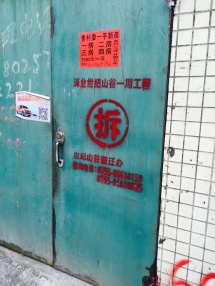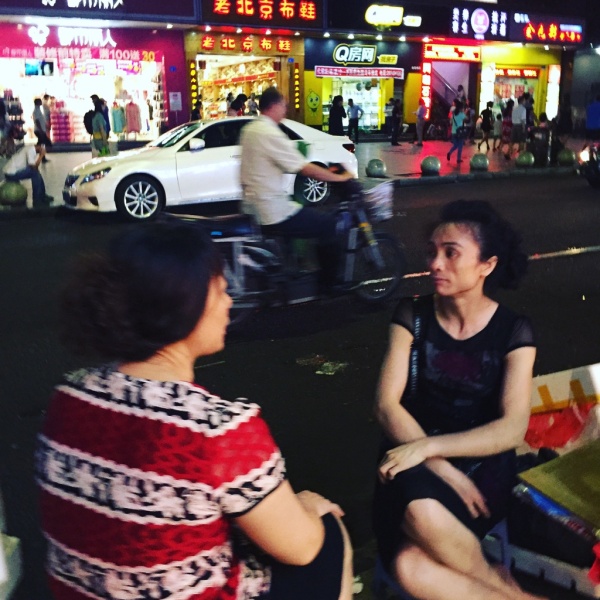Vibrant Baishizhou: An urban village endangered #ShenzhenDiaries
Posted by ramblinginthecity
All the while Mary Ann and Fu Na were with us in Delhi, we talked about urban villages. The discussions often left me confused and I had realized that we weren’t talking about quite the same animal. Our walk through Baishizhou, the first urban village we saw in Shenzhen, was all about finding the similar and understanding the different.
We take a narrow road into Baishizhou, walking alongside tall iron fencing that contain the various gated housing condominiums of OCT, privately built and owned, expensive, home to the better off, orderly, landscaped and pretty. At a cluster of shops at the village entrance, we find the little mobile phone with the resourceful entrepreneur who can fiddle around with sim cards and Indian mobile phones and get us connected, something the uniformed salesperson in the branded telecom store hadn’t been able to do. The cheerful shopkeeper’s daughter entertains us as he works. The lady next door selling buns cannot mask her curiosity. A number of village folk sit around, play mahjong, gossip. I feel at home, the hustle bustle is comforting.
This slideshow requires JavaScript.
Inside Baishizhou, the shop-lined narrow streets are thronging with hundreds of children who are spilling out of the school gate ahead. The blue and checked uniforms appear to move with a sense of purpose towards whatever is scheduled next for them. We get some stares and shy smiles, hear a lot of chatter. Conversation moves from child sex ratio to schooling practices and parental ambition. The busy streets, all manner of shops including the barber shops with the characteristic twirling striped cylinders, an excess of signages, walls pasted with advertisements for rental space and narrow, cluttered side alleys and narrow market lanes are strongly reminiscent of similar bustling informal settlements in Delhi. We see the ubiquitous 25-liter water here in Baishizhou, the same as Mary Ann and Fu Na saw in Chakkarpur village, Gurgaon. Cables run along external walls and across the street. It’s a familiar kind of chaos.
This slideshow requires JavaScript.
This slideshow requires JavaScript.
As we get accustomed to the eye level and crane our necks upwards though, we begin to see how an urban village in Shenzhen is different from what we’re used to back home. The famous ‘handshake’ buildings are much taller here, 7-10 floors high as compared to the 3-4 floors in Delhi. They have tiled facades. Whoever built them had certainly used a plumb line!
Like in Delhi, villagers had redeveloped their plots to build high-rise apartments that they rented out to migrants. From the height and quality of the buildings, however, it seemed that they had access to more capital and better construction expertise. Once, we came across a single family home, a couple floors high and with space for a front yard and this offered us a glimpse of what Baishizhou might have been a few decades ago.
This slideshow requires JavaScript.
At the edge of the village, we stare at a row of factory buildings slated for demolition. This is the first bit of Baishizhou to go in an inevitable cycle of demolition and redevelopment that has been ongoing in Shenzhen. Many more conversations about the inequitable impacts of redevelopment in Shenzhen are to follow, through which the relevance of the Baishizhou we see was brought home to us. The famous ‘chai’, the Chinese symbol for destruction, is stenciled across the structures, stark and grim.
As the shadows lengthen and we head back to the hotel, we watch an endless stream of people walking back to Baishizhou at the end of what would most likely have been a long working day. The prospect of hanging around till the streets became a frenzied den of leisure activity, largely focused around food (apparently people from Guangzhou atake care of their taste buds!) is welcome, but we haven’t had much sleep and rest is on our minds. And so we walk away.
Luckily for us, we do get a chance to revisit Baishizhou by night, the last evening before we head back to India. And though we miss the crowds, we do get a different sense of this village that probably never really sleeps.
About ramblinginthecity
I am an architect and urban planner, a writer and an aspiring artist. I love expressing myself and feel strongly that cities should have spaces for everyone--rich, poor, young, old, healthy and sick, happy or depressed--we all need to work towards making our cities liveable and lovable communities.Posted on June 19, 2016, in Shenzhen Diaries, Travel & Experiences and tagged Baishizhou, chengzhongcun, China, construction, density, mixed use, Redevelopment, rental housing, schoolkids, Shezhen, social life, street markets, streetfood, urban village. Bookmark the permalink. 2 Comments.









Love the pictures and expression of life. One can sense lot of similarities with India, the flats and life. I may be wrong through my perception. Every city showcases life in all its forms.
Pingback: Do large-scale cultural events help neighborhoods? Reflections on the #UABB in Nantou, Shenzhen | ramblinginthecity